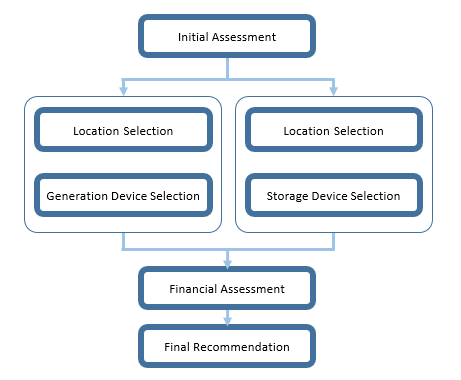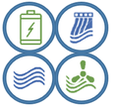The uptake of small scale marine generation technologies would allow for a degree of energy independence for island communities which would be otherwise reliant on expensive grid connections to the mainland. Unfortunately, there is a lack of readily accessible information available in order to make informed decisions regarding available resources and methods of generation or storage; this may lead to unnecessarily wasted time and effort considering unsuitable options.
Therefore, a tool which is able to assess the existing, local electricity infrastructure, quantify suitable resources and generation or storage devices, and also present this is a clear and concise manner would most likely prove useful. Additionally, in the interest of uniformity, the European Marine Energy Centre have been taking steps to standardise the process by which marine resources are assessed and quantified, thus the intention for the advisory tool is that it addresses the first two stages in this process such that island communities are able to make a well-informed decision prior to moving ahead with the later, more technically and administratively dense portions of the project.
Therefore, a tool which is able to assess the existing, local electricity infrastructure, quantify suitable resources and generation or storage devices, and also present this is a clear and concise manner would most likely prove useful. Additionally, in the interest of uniformity, the European Marine Energy Centre have been taking steps to standardise the process by which marine resources are assessed and quantified, thus the intention for the advisory tool is that it addresses the first two stages in this process such that island communities are able to make a well-informed decision prior to moving ahead with the later, more technically and administratively dense portions of the project.
To prove useful, the methodology and subsequent advisory tool must be founded upon a logical approach to the problem. The key steps, and their position relative to one another in the process can be seen below:
1. Initial Assessment
A scoping stage, eliminating specific sites for generation and establishing an understanding of the existing system and baseline against which to judge modifications to the system. Additionally, at this stage, a decision is made upon which path would be most beneficial: generation or storage capacity.
2. Location: Generation or Storage
Following the initial assessment, suitable sites are compared using weighted matrices and specified criteria to determine the most advantageous site.
3. Device: Generation or Storage
A technical database is used to match suitable generation or storage technologies with the identified site of interest.
4. Financial Assessment
Selected devices, the best performing three, are assessed based upon a predicted levelised cost of energy and comparisons are drawn with the existing system to identify potential benefits.
5. Final Recommendation
A recommendation is made regarding which generation or storage technology and which location merit further investigation as a viable addition to the existing network.
A scoping stage, eliminating specific sites for generation and establishing an understanding of the existing system and baseline against which to judge modifications to the system. Additionally, at this stage, a decision is made upon which path would be most beneficial: generation or storage capacity.
2. Location: Generation or Storage
Following the initial assessment, suitable sites are compared using weighted matrices and specified criteria to determine the most advantageous site.
3. Device: Generation or Storage
A technical database is used to match suitable generation or storage technologies with the identified site of interest.
4. Financial Assessment
Selected devices, the best performing three, are assessed based upon a predicted levelised cost of energy and comparisons are drawn with the existing system to identify potential benefits.
5. Final Recommendation
A recommendation is made regarding which generation or storage technology and which location merit further investigation as a viable addition to the existing network.



